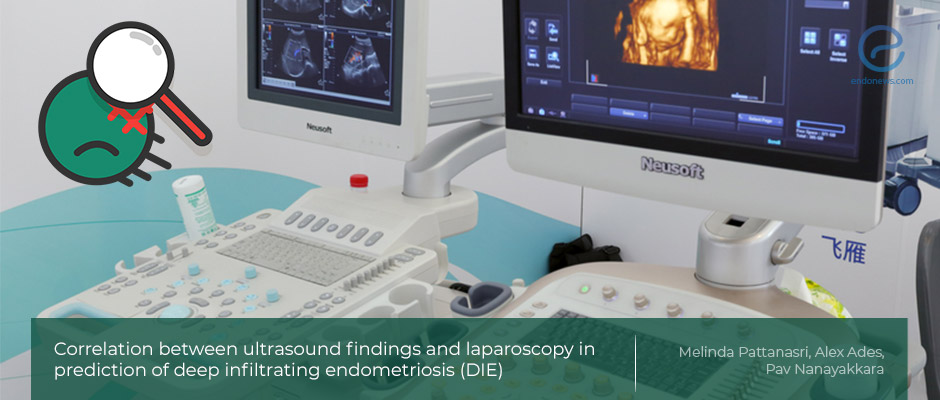Ultrasound for the Detection of Deep Infiltrating Endometriosis
Feb 9, 2021
What are the limitations of Ultrasound for the Detection of Endometriosis?
Key Points
Importance:
- Transvaginal ultrasonography (TVUS) is an effective, first-line tool for the assessment of clinically-suspicious deep infiltrating endometriosis (DIE) but is a highly operator-dependent modality.
Highlights:
- This is a retrospective cohort study that found TVUS to be accurate in the detection of DIE in the hands of experienced ultrasound operators.
What’s done here:
- The aim of this study is to assess the accuracy of TVUS in predicting DIE by comparing gold standard laparoscopic findings.
- A total of 119 patients were included in this study after inclusion and exclusion criteria were met.
Key Results:
- TVUS was shown to be useful in detecting all but bladder DIE.
- Community TVUS was no better than chance at identifying most DIE, except for the detection of ovarian endometriomas and adhesions.
- Specialist TVUS correctly identified most DIE with the greatest utility for DIE in rectosigmoid, followed by the pouch of Douglas, endometriomas and ovarian adhesions, uterosacral ligaments, and rectovaginal septum with high statistical specificity.
Limitations:
- Assessment of operative differences among “community” and “specialist” operators did not take into account the specific type of symptom during sub-analysis of different pelvic regions.
- The study did not accurately account for bowel preparation in the “community” and “specialist” group analysis which may have skewed DIE subgroup analysis.
Lay Summary
Endometriosis is a disease that causes significant morbidity to women worldwide. Deep infiltrating endometriosis (DIE) is a term used to characterize endometriosis that has invaded deeper pelvic structures and is associated with significant inflammatory, fibrotic, and surgically complex disease. Depending on the structures involved, surgical management of DIE varies. Thus, evaluating and diagnosing DIE before symptom progression optimizes long-term prognosis. MRI and transvaginal ultrasonography (TVUS) are commonly used to achieve a further evaluation of cases where DIE is suspected. Often, TVUS is the first examination that is employed due to its cost-effective nature and accessibility. Similar to other forms of ultrasonographic evaluation, TVUS is highly operator dependent given the technical and real-time evaluation required to achieve a thorough study.
This retrospective cohort study by Pattanasri et al. included 119 patients who underwent laparoscopy between 2014-2019 by a single surgeon for clinically suspected endometriosis after inclusion and exclusion criteria were met. The inclusion criterion was the TVUS examination done prior to laparoscopy, and the exclusion criterion was laparoscopy for other indications not including endometriosis. TVUS examinations were performed by individuals with a Certification in Obstetric and Gynaecological Ultrasound (COGU) which is used in Australia.
Clinical information gathered included demographic information, symptoms, TVUS, and surgical findings. TVUS findings of the presence of ovarian endometriomas/ovarian adhesions, the pouch of Douglas (POD) DIE/POD adhesions, bladder, and utero-vesical fold DIE, rectosigmoid DIE, rectovaginal septum DIE, and uterosacral ligament DIE were recorded. The documented presence of DIE on laparoscopy and confirmed by histology. The ability of TVUS as a diagnostic tool in the assessment of DIE was statistically evaluated.
The authors found that TVUS, in the hands of “community” versus “specialist” operators performed very differently, especially in the detection of harder to assess rectosigmoid, ovarian endometrioma, ovarian adhesions, and rectovaginal septum DIE involvement. Authors also found that those patients who were symptomatic and received a community USS (n = 27) had a low diagnostic value1, except for the detection of ovarian endometriomas and ovarian adhesions. Authors found that TVUS was not useful in either community or specialist settings at detecting bladder-uterovaginal fold DIE. In this study, only one patient who had DIE of the bladder/uterovaginal fold was identified on TVUS; however, 25% had the disease in this geographical location on laparoscopy.
This study largely reflects the already known concept that ultrasonographic operators should be trained specifically for the evaluation of endometriosis given its clinical complexity was published in the ANZJOG.
Research Source: https://pubmed.ncbi.nlm.nih.gov/32895927/
ultrasound imaging resident physician trainee

